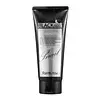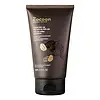What's inside
What's inside
 Key Ingredients
Key Ingredients

 Benefits
Benefits

 Concerns
Concerns

 Ingredients Side-by-side
Ingredients Side-by-side

Water
Skin ConditioningMyristic Acid
CleansingGlycerin
HumectantStearic Acid
CleansingPotassium Hydroxide
BufferingSorbitol
HumectantGlyceryl Stearate
EmollientGlycol Distearate
EmollientPEG-2 Stearate
EmulsifyingCharcoal Powder
AbrasiveSodium Hyaluronate
HumectantSnail Secretion Filtrate
Skin ConditioningHydroxyethyl Urea
HumectantBetaine
HumectantFicus Carica Fruit/Leaf Extract
Skin ConditioningAesculus Hippocastanum Extract
AntioxidantUlmus Davidiana Root Extract
Skin ConditioningDiospyros Kaki Leaf Extract
Skin ProtectingButylene Glycol
HumectantChamaecyparis Obtusa Leaf Extract
Skin ConditioningBambusa Vulgaris Leaf/Stem Extract
HumectantBetula Alba Bark/Leaf Extract
Astringent1,2-Hexanediol
Skin ConditioningEthylhexylglycerin
Skin ConditioningDisodium EDTA
Parfum
MaskingWater, Myristic Acid, Glycerin, Stearic Acid, Potassium Hydroxide, Sorbitol, Glyceryl Stearate, Glycol Distearate, PEG-2 Stearate, Charcoal Powder, Sodium Hyaluronate, Snail Secretion Filtrate, Hydroxyethyl Urea, Betaine, Ficus Carica Fruit/Leaf Extract, Aesculus Hippocastanum Extract, Ulmus Davidiana Root Extract, Diospyros Kaki Leaf Extract, Butylene Glycol, Chamaecyparis Obtusa Leaf Extract, Bambusa Vulgaris Leaf/Stem Extract, Betula Alba Bark/Leaf Extract, 1,2-Hexanediol, Ethylhexylglycerin, Disodium EDTA, Parfum
Water
Skin ConditioningCoffea Arabica Seed Powder
AbrasiveCetearyl Alcohol
EmollientCocamidopropyl Betaine
CleansingCarthamus Tinctorius Seed Oil
MaskingGlyceryl Stearate
EmollientC15-19 Alkane
SolventGlycerin
HumectantCeteareth-20
CleansingCeteareth-12
EmulsifyingTheobroma Cacao Seed Butter
EmollientButyrospermum Parkii Butter
Skin ConditioningC10-18 Triglycerides
EmollientOlus Oil
EmollientCetyl Palmitate
EmollientGlycine Soja Sterols
EmollientPhospholipids
Skin ConditioningGlycolipids
Skin ConditioningHydroxypropyl Starch Phosphate
Glycine Soja Oil
EmollientSodium Stearoyl Glutamate
CleansingAcrylates/C10-30 Alkyl Acrylate Crosspolymer
Emulsion StabilisingTocopherol
AntioxidantXanthan Gum
EmulsifyingPhenoxyethanol
PreservativeSodium Hydroxide
BufferingEthylhexylglycerin
Skin ConditioningTrisodium Ethylenediamine Disuccinate
Water, Coffea Arabica Seed Powder, Cetearyl Alcohol, Cocamidopropyl Betaine, Carthamus Tinctorius Seed Oil, Glyceryl Stearate, C15-19 Alkane, Glycerin, Ceteareth-20, Ceteareth-12, Theobroma Cacao Seed Butter, Butyrospermum Parkii Butter, C10-18 Triglycerides, Olus Oil, Cetyl Palmitate, Glycine Soja Sterols, Phospholipids, Glycolipids, Hydroxypropyl Starch Phosphate, Glycine Soja Oil, Sodium Stearoyl Glutamate, Acrylates/C10-30 Alkyl Acrylate Crosspolymer, Tocopherol, Xanthan Gum, Phenoxyethanol, Sodium Hydroxide, Ethylhexylglycerin, Trisodium Ethylenediamine Disuccinate
Ingredients Explained
These ingredients are found in both products.
Ingredients higher up in an ingredient list are typically present in a larger amount.
Ethylhexylglycerin (we can't pronounce this either) is commonly used as a preservative and skin softener. It is derived from glyceryl.
You might see Ethylhexylglycerin often paired with other preservatives such as phenoxyethanol. Ethylhexylglycerin has been found to increase the effectiveness of these other preservatives.
Glycerin is already naturally found in your skin. It helps moisturize and protect your skin.
A study from 2016 found glycerin to be more effective as a humectant than AHAs and hyaluronic acid.
As a humectant, it helps the skin stay hydrated by pulling moisture to your skin. The low molecular weight of glycerin allows it to pull moisture into the deeper layers of your skin.
Hydrated skin improves your skin barrier; Your skin barrier helps protect against irritants and bacteria.
Glycerin has also been found to have antimicrobial and antiviral properties. Due to these properties, glycerin is often used in wound and burn treatments.
In cosmetics, glycerin is usually derived from plants such as soybean or palm. However, it can also be sourced from animals, such as tallow or animal fat.
This ingredient is organic, colorless, odorless, and non-toxic.
Glycerin is the name for this ingredient in American English. British English uses Glycerol/Glycerine.
Learn more about GlycerinGlyceryl Stearate is a mix of glycerin and stearic acid.
It is used to stabilize the mixing of water and oil ingredients. By preventing these ingredients from separating, it can help elongate shelf life. It can also help thicken the product's texture.
As an emollient, it helps soften skin and supports barrier-replenishing ingredients.
In cosmetics, Glyceryl Stearate is often made from vegetable oils or synthetically produced.
This ingredient may not be fungal-acne safe
Fun fact: The human body also creates Glyceryl Stearate naturally.
Learn more about Glyceryl StearateWater. It's the most common cosmetic ingredient of all. You'll usually see it at the top of ingredient lists, meaning that it makes up the largest part of the product.
So why is it so popular? Water most often acts as a solvent - this means that it helps dissolve other ingredients into the formulation.
You'll also recognize water as that liquid we all need to stay alive. If you see this, drink a glass of water. Stay hydrated!
Learn more about Water